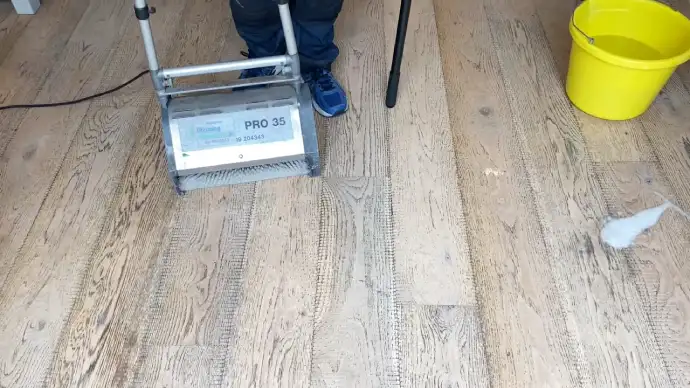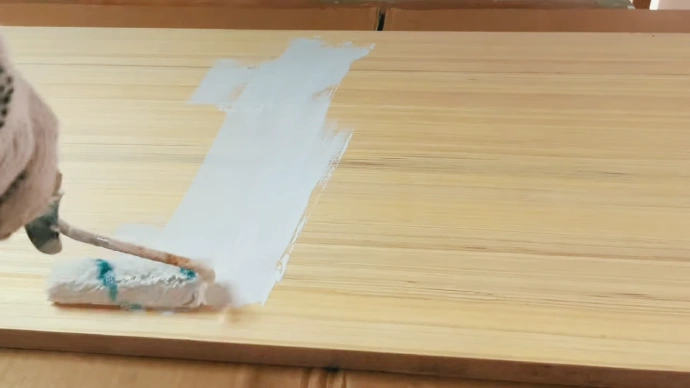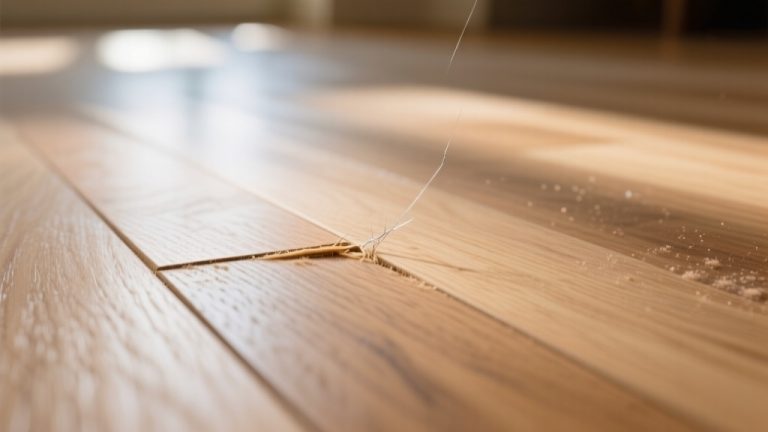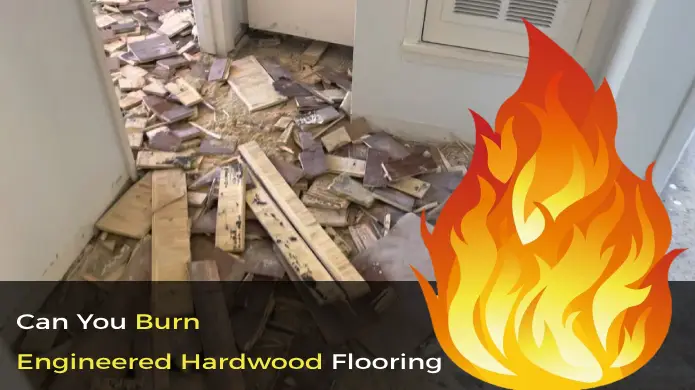How to Clean Unsealed Hardwood Floors: Easy Methods to Follow [Must Know]
Unsealed hardwood floors are a beautiful addition to any home but require special cleaning attention and care. Unlike sealed hardwood floors, unsealed ones lack the protective layer that prevents moisture from seeping into the wood and damaging its natural beauty.
Thus, cleaning unsealed hardwood floors using appropriate cleaning methods is essential. Unsealed hardwood floors can be cleaned with vinegar or natural oils by vacuuming the floors, applying cleaning agents, and then cleaning them.
Let’s discuss two easy methods for cleaning unsealed hardwood floors while preserving their natural charm. We will also address some commonly asked questions regarding cleaning unsealed hardwood floors.
How to Clean Unsealed Hardwood Floors: Two Easy Methods
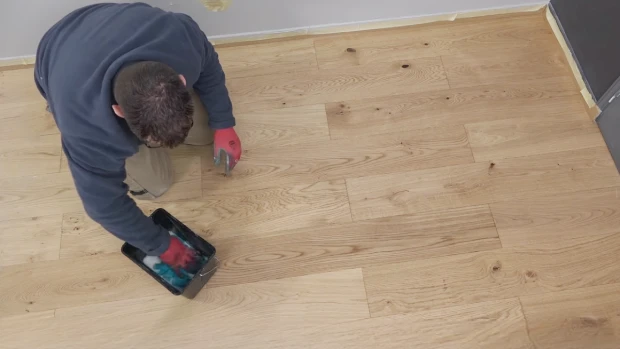
When it comes to cleaning unsealed hardwood floors, there are two easy methods that you can use.
Method 1. Cleaning Unsealed Hardwood Floors with Vinegar
Cleaning unsealed hardwood floors with vinegar is a simple and effective method for removing dirt, grime, and other impurities that build up over time. Vinegar is a mildly acidic solution that helps to loosen and dissolve stubborn stains, making it an ideal solution for cleaning hardwood floors.
Here are some easy steps to follow:
Step 1. Gather All Materials
The first step in maintaining a pristine and polished surface underfoot is to assemble the necessary materials, including:
- A mop,
- Bucket,
- Vinegar,
- Clothes or rags, and
- Broom.
Step 2. Vacuum the Floor to Remove Loose Dust
Removing loose dust by vacuuming is essential in maintaining a polished surface underfoot. It ensures the subsequent mopping process effectively penetrates the dirt and grime buildup.
The presence of dust particles can scratch and damage unsealed hardwood floors, leading to premature wear and tear. To avoid this, using a soft bristle brush attachment on your vacuum cleaner when cleaning hardwood floors is important.
Here are three items to keep in mind when vacuuming:
- Remove all small objects or debris from the floor before you start vacuuming.
- Use a high-quality vacuum with strong suction power for efficient cleaning.
- Vacuum along the grain of the wood to prevent any scratches or marks on the surface of your floor.
Step 3. Prepare the Cleaning Solution
Mixing white vinegar and warm water in a bucket is akin to creating a potion that can transform the appearance of your wooden surface, leaving it sparkling clean and free from grime.
White vinegar is an effective yet gentle cleaner that can remove dirt and stains without harming the wood’s natural finish. Combining 1 cup of white vinegar with 1 gallon of warm water creates a safe and non-toxic cleaning solution for unsealed hardwood floors.
This solution should only be used on unsealed floors, as sealed surfaces may require different cleaning methods to maintain their protective coating Once the cleaning solution has been prepared, it can be applied using a mop or cloth, removing excess moisture immediately to prevent water damage.
Step 4. Clean the Floor with Solution
Using the vinegar solution previously prepared, apply the cleaning mixture onto the surface with a mop or cloth, ensuring that excess moisture is removed to prevent potential water damage.
Dip the mop or cleaner into the vinegar solution and wring it out before sweeping the floor, removing as much dirt as possible. Avoid soaking the floor by wringing out the mop or cleaner thoroughly.
Remember that unsealed hardwood floors are more susceptible to water damage than sealed ones. Therefore, care should be taken not to oversaturate them with liquid.
Working in sections and drying each section immediately after cleaning with a dry cloth is recommended. This will help maintain the integrity of your flooring and prevent warping or buckling caused by excessive moisture exposure.
Step 5. Dry the Floor With a Cloth
After cleaning the surface with the vinegar solution, you must dry the floor thoroughly with a clean cloth to prevent water damage and maintain the quality of your flooring.
The excess moisture from the cleaning solution can seep into unsealed hardwood floors and cause warping or discoloration over time, which can be difficult and expensive to fix.
Therefore, using a dry cloth immediately after cleaning will ensure that all remaining moisture is absorbed and will help preserve the natural beauty of your wood floors.
Method 2. Cleaning Unsealed Hardwood Floors with Natural Oils

Natural oils like jojoba or linseed oil are non-toxic, eco-friendly, and safe for hardwood floors. They work by penetrating deep into the wood’s pores, providing nourishment and hydration to the wood, and leaving a protective barrier that prevents future damage.
Here are the steps to follow:
Step 1. Vacuum the Floor to Eliminate Loose Dust
In order to prepare an inviting and hygienic living space free of airborne pollutants and allergens, it is crucial to carefully remove any loose debris or dust particles from the room’s surfaces.
This is especially important when cleaning your unsealed hardwood floors, as they are more susceptible to damage than their sealed counterparts. To effectively remove loose dust, follow these steps:
- Start using a soft-bristled broom or vacuum cleaner with a floor brush attachment to sweep the entire area.
- Pay special attention to corners, edges, and hard-to-reach areas where dust accumulates.
- Use a microfiber cloth or mop dampened with water to wipe away any remaining dirt or debris after vacuuming. Avoid using excessive amounts of water as it can cause damage to the wood.
Step 2. Apply the Oil on a Clean Microfiber cloth
A dry and residue-free floor can be achieved by applying jojoba or linseed oil onto a microfiber cloth. After vacuuming the floor to remove loose dust, it is important to use a clean microfiber cloth to apply the oil.
These oils help in removing surface residue, and at the same time, they keep the hardwood floors hydrated, which helps prevent cracking on its surface. Ensure that excess oil is not applied as this may leave streaks or cause discoloration of the wood.
A small amount of oil goes a long way. Therefore, working in sections while applying it to the floor for an even distribution is advisable. Once all parts have been covered with the oil, allow it to sit for around 10 minutes before wiping off any excess using another clean microfiber cloth.
Step 3. Swipe the Unsealed Floor with the Damp Cloth
Incorporate a gentle swipe of a dampened cloth over the surface of the unvarnished flooring. It can aid in removing any excess oil residue left behind from the previous step, ensuring a polished and lustrous finish.
This is crucial in maintaining the natural beauty of hardwood floors without causing damage or warping due to excessive moisture. When swiping with the damp cloth, it’s essential to use minimal pressure while ensuring that all areas are evenly covered for optimal cleaning.
Step 4. Remove the Oil With a Dry Mop or Cloth
Using a dry mop or cloth, the excess oil can be effectively removed from the surface of the unsealed hardwood flooring. This step is crucial for achieving a refined and polished appearance.
The dry mop or cloth should be used immediately after wiping with a damp cloth to prevent water damage to the wood. Using a microfiber mop or cloth is recommended as it will attract and hold onto dirt and grime without scratching the surface.
The mop should be gently dragged across the floor in straight lines, ensuring that all excess oil is absorbed. Repeat this step until all oil has been removed from the flooring.
Tips For Maintaining Your Unfinished Wood Flooring After Cleaning

After cleaning your floors, there are specific steps you can take to ensure their longevity and durability. Here are some caring tips for maintaining the unfinished wooden flooring:
Avoid Wet-Mopping
While it may seem like a good idea to clean your floors with water, this can cause damage to unfinished wood. Instead, it’s best to use a dry mop or a vacuum to pick up debris or dust.
If you need to clean up a spill, use a slightly damp cloth and dry it immediately. This will prevent water from seeping into the wood and causing warping or staining.
Choose the Right Wood Care Products
When caring for unfinished wood flooring, the products you use are crucial. Avoid harsh chemical cleaners or anything that contains wax or oil. Instead, opt for products specifically designed for unfinished or natural wood, like mineral spirits, vinegar, or specialized wood cleaners.
Gently Sand the Stained Area
If you do happen to have a stain on your unfinished wood flooring, gently sanding the affected area can help remove it. Use fine-grit sandpaper and lightly sand in the direction of the wood grain. Be careful not to sand too deeply, which can damage the wood.
Avoid Floor Soaking
When cleaning your floors, avoiding soaking the wood in water is crucial. This can cause the wood to expand and warp, leading to costly repairs. Instead, use a damp mop or cloth to clean up spills or debris.
Try to Avoid Spills
While spills are inevitable, cleaning them up immediately is important to prevent any damage to your floors. Be sure to use a slightly damp cloth, and avoid letting water sit on the wood for too long.
Use Floor Protector Pads
To prevent scratches and dents on your unfinished wood flooring, using floor protector pads on furniture legs or any other objects that may come in contact with the floor is a good idea.
Mind the Indoor Humidity
Humidity levels can greatly affect unfinished wood flooring. During the colder months, it’s important to maintain a humidity level of around 40-50% to prevent the wood from drying out and cracking. In the summer, use a dehumidifier to keep the moisture levels in check.
Trim Your Dog’s Nails Regularly
If you have a furry friend at home, their nails can cause damage to your unfinished wood floors. Be sure to trim their nails regularly to prevent scratches or dents in the wood.
Avoid Wearing Shoes in the House
Wearing shoes inside your home can cause a lot of wear and tear on your unfinished wood flooring. To prevent damage, it’s best to leave your shoes at the door and wear slippers or socks inside instead.
What is the best way to clean hardwood floors?
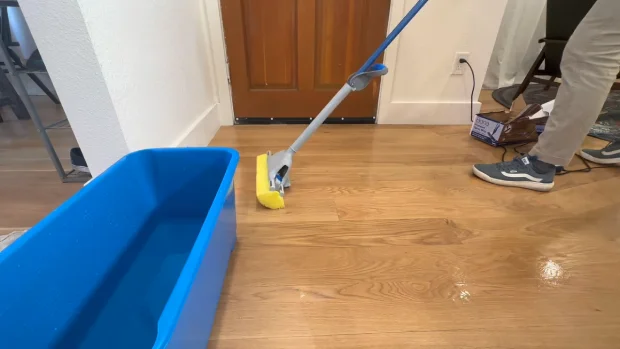
Implementing a regular cleaning routine is crucial to maintaining their longevity and appearance for the upkeep of wooden surfaces. Studies show that investing in preventative measures such as frequent dusting can decrease the likelihood of scratches and dents.
When cleaning hardwood floors, there are several effective methods to choose from. One approach is using a broom or hardwood floor mop for daily cleaning. This method helps remove dirt and debris from the surface without damaging its finish.
Another option involves using a specialized cleaning solution designed for hardwood floors. These solutions are formulated to clean wood without causing any damage or leaving unwanted residue behind.
Can I steam mop unsealed wood floors when cleaning?
Steam mopping might seem like an efficient way of cleaning, but the high-temperature steam can penetrate deep into the wood fibers and cause wood warping.
Excessive moisture from steam mopping can cause irreversible damage to wooden surfaces, making it imperative to avoid using steam mops when maintaining cleanliness. This is especially true for unsealed hardwood floors, which are more porous and vulnerable to water damage than their sealed counterparts.
Can I use Murphy’s oil soap on unfinished wood for cleaning?

Murphy’s Oil Soap is a popular household cleaner that can safely apply to unfinished wooden surfaces, with over 80% of households. The good news is that Murphy’s Oil Soap is a safe and effective cleaning solution for unsealed hardwood floors.
Using Murphy’s Oil Soap on unsealed wood will help clean the surface while protecting it from damage. Using the product as directed is important, which typically involves mixing it with water before applying it to the floor.
A gentle scrubbing motion should remove dirt or debris from the surface, followed by a thorough rinse with clean water. One thing to remember when using any cleaning product on unsealed wood is that excessive moisture can cause damage.
Be sure not to oversaturate the floor during cleaning, as this can lead to warping or discoloration of the wood.
Elegant Living with Unsealed Hardwood Floors: Keep them Clean for Enduring Beauty
Unsealed hardwood floors represent simplicity, purity, and authenticity. The beauty of unsealed hardwood floors is undeniable, but keeping them clean can be a challenge.
Therefore, you must treat them gently to preserve their essence. However, with the right cleaning methods, you can maintain their natural look and feel for years.
Two easy ways to clean your unsealed hardwood floors include using a damp mop with water or vinegar solution and a soft-bristled brush with gentle soap and water.
It is crucial to avoid harsh chemicals or abrasive tools when cleaning unsealed hardwood floors as they can damage the wood’s surface. Your unsealed hardwood floors will continue to exude sophistication and elegance with proper care and attention.

